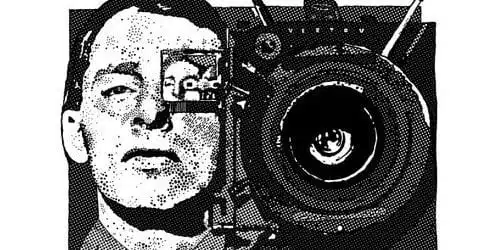
Cinema Different: Different Cinema Volume 3 from Microcinema International presents nine films which were selected for the 10th anniversary of the Festival des Cinémas Differents de Paris. They range in duration from three- to 12-minutes and use a variety of formats including super 8, 16mm and digital video. Most of the artists are French but represent a wide variety of approaches and together they present a broad range of techniques and approaches used by contemporary experimental artists working in film and video. But be forewarned: there’s no traditional narrative films in the lot. These artists are experimenting with communication at the abstract end of the spectrum.
The first film on the DVD is also the oldest: Marguerite Duras’ 1979 Césarée. It’s also one of the most radical: Duras’ infamous comment “I approach cinema with the intent to murder it” could be applied to this film which is constructed of discarded footage from her film Le navire Night accompanied by narration spoken by Duras which is at best obliquely connected with the images. While the text is describing the wheat of Galilee and Lake Tiberias, the images are of the gardens of the Tuileries.
Isabelle Blanche embraces the restrictions imposed by working in super 8 and her Idéal (Fin de l’)) is, like most of her films, the length of a super 8 cartridge (3’38” in this case). It consists of a series of rapidly changing and off center static shots of faces accompanied by a mechanical soundtrack which cumulatively produce an almost hypnotic effect. Empreinte by Xavier Baert is a silent and highly abstract 12’ film presenting partial glimpses of a dancer who is never seen in his entirety; although shot in color the hues are so washed out the effect is similar to black and white. Augustin Gimel’s L’oiel Lourd du Voyage Mécanique attempts to break up habitual habits of seeing by cutting a travelogue-like color film into a series of staccato bursts.
Untitled No. 1 by Russian artist Masha Godovannaya evokes the memory of a girl Godovannaya observed in the Nevskiy Prospect in St. Petersburg. Shot in black and white on super 8, it presents haunting images of young girl doing a Flamenco-like dance accompanied by driving guitar music and intercut with images of crowds and monuments. Fréderic Tachou’s Reste-Là! also uses a guitar-heavy soundtrack in a film inspired by a dream about his father. Shot in 16mm it opens with a split screen which presents views of a house in a deliberately disorienting manner. A man and then a boy appear and disappear seemingly randomly before the film returns to the deserted landscape and interiors, finally ending in a white out.
The Canadian artist Richard Kerr has been working in avant-garde cinema since the ’70’s, making him next to Duras the senior statesman in this collection. He uses both digital and manual techniques in the eight-minute color film Le Bombardement. Le Port Des Perles, a reworking of the trailer for the 2001 Hollywood movie Pearl Harbor. Kerr’s work is so abstract that the connection is not obvious merely from viewing the film but once seen in that light it becomes a commentary on and criticism of the commercial film industry.
Desde la Memoria by German artist Christina von Greve, a 3’ film shot in color and white on Beta, is the most approachable film in this collection. It combines historical (black and white) and contemporary (color) footage with the words of survivors of the Spanish Civil War and the Franco dictatorship which followed, thus creating a collage which reflects on the privations of that time. Memorably, one survivor recalls: “I saw dogs running through the streets with pieces of human flesh. As long as I live I will never get that picture out of my head.”
Cabinet by Boston-based filmmaker Robert Todd, shot in black and white and color on 16mm, wanders through a city presenting views sometimes recognizable and sometimes deliberately not, accompanied by a variety of sounds.
The DVD for Different Cinema volume 3 is encoded on one side in PAL format and on the opposite in NTSC format. For the films which include spoken text, subtitles are included in English, French and Spanish. It comes with a small package of extras including an eight-page booklet in French and English (which manages to be even more oblique than most of the films), a trailer for the festival, and biographies and selected filmographies for the artists.
